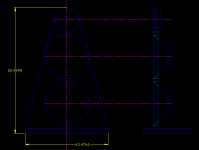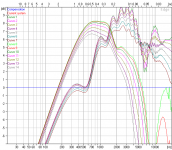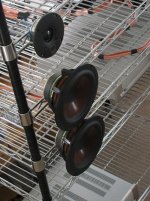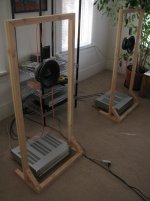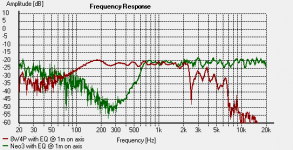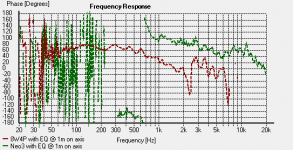I'd like to throw together a quick and dirty open baffle as a double check before proceeding on to more involved projects. The speaker would be a prototype to give me some in depth listening time with an OB to see what I think of dipole sound after living with it for a while. Regardless of the conclusion I reach the speaker's going to be a throwaway after a month or so of listening, so the emphasis here is quick and easy to build on the cheap. I don't want to buy drivers, so I'd like to reuse the drivers from my current two way box speakers---Vifa BC25TG19 tweeters and paired 6.5" OEM woofers that are quite similar to the Vifa XT18WH09. This limits the total woofer Sd per speaker to 258 cm^2 (both woofers combined) and excursion to about 5mm.
Driver wise, the result is rather similar to Gainphile's S11, though he's got one big woofer where I've two. I've been following StigErik's Beyama thread and, while I don't have the Sd to go baffleless, back of the envelope numbers from Linkwitz's dipole SPL suggest I could get ~80dB at 75Hz with a minimal baffle and a listening distance around 2m. Enough for my evaluation purposes and I'm curious to hear how reducing the baffle around the tweeter influences the sound. This led me to the S11 and StigErik inspired design in the attached images (the dimensions are in inches and the Edge curves are successive steps off axis for the tweeter and woofers, starting on the tweeter axis and going out to 30 degrees off axis horizontally). The round top is the tweeter mounting flange and, as you'd expect from a round object 100mm in diameter there's a bad diffraction suck out at 6600Hz. I have measurement gear and a biamp with a PC crossover. EQing the dipole rolloff and the suck out is just an MLS run followed by some mouse clicks.
This is my first OB build so before I start cutting MDF I thought I'd put the design out for more experienced eyeballs to look at. Constructive feedback appreciated---I know it'd be better with a bigger baffle, three or four way with bigger woofers and so on, but the point of this exercise is to quickly check that I like OBs enough to invest effort in building a better one. Note that the drawing is rough and doesn't include finishing touches such as chamfered mounting holes for the woofers. The panel that holds the tweeter would screw into the upper woofer and tweeter flanges.
Driver wise, the result is rather similar to Gainphile's S11, though he's got one big woofer where I've two. I've been following StigErik's Beyama thread and, while I don't have the Sd to go baffleless, back of the envelope numbers from Linkwitz's dipole SPL suggest I could get ~80dB at 75Hz with a minimal baffle and a listening distance around 2m. Enough for my evaluation purposes and I'm curious to hear how reducing the baffle around the tweeter influences the sound. This led me to the S11 and StigErik inspired design in the attached images (the dimensions are in inches and the Edge curves are successive steps off axis for the tweeter and woofers, starting on the tweeter axis and going out to 30 degrees off axis horizontally). The round top is the tweeter mounting flange and, as you'd expect from a round object 100mm in diameter there's a bad diffraction suck out at 6600Hz. I have measurement gear and a biamp with a PC crossover. EQing the dipole rolloff and the suck out is just an MLS run followed by some mouse clicks.
This is my first OB build so before I start cutting MDF I thought I'd put the design out for more experienced eyeballs to look at. Constructive feedback appreciated---I know it'd be better with a bigger baffle, three or four way with bigger woofers and so on, but the point of this exercise is to quickly check that I like OBs enough to invest effort in building a better one. Note that the drawing is rough and doesn't include finishing touches such as chamfered mounting holes for the woofers. The panel that holds the tweeter would screw into the upper woofer and tweeter flanges.
Attachments
Last edited:
The round top is the tweeter mounting flange and, as you'd expect from a round object 100mm in diameter there's a bad diffraction suck out at 6600Hz. I have measurement gear and a biamp with a PC crossover. EQing the dipole rolloff and the suck out is just an MLS run followed by some mouse clicks.
That is basicly wrong. If you EQ the suck out for 0 deg, you will get large peaks off axis. This suck out is an acoustic phenomenon that can´t be cured by EQ. There are only acoustic 'solutions' to it:
1. Getting a smaller tweeter will reduce the baffle size and move the suck out up in frequency. But there is no tweeter that will push the suck out out of your hearing range
2. making the baffle wider does not avoid diffraction. But it will 'smear' that suck out over a wider frequency range - possibly making it look better in diagrams and easier on the ear. A big hump in the power response will still exist.
Thanks! I agree it's a compromised design. If this were a production project I'd choose different tweeters or mill the tweeter flange so it's not constant distance from the acoustic center to produce the diffraction smearing Rudolf mentioned. But, as it'll be a short lived throwaway speaker, I'm willing to EQ it for a narrow sweet spot and spend the five minutes it takes to redo the EQ if I move the listening position. I didn't want to bias the initial response, but since you two OB masters have zeroed on what seems to be the only issue that's a potential showstopper, the specific question I have is whether there's too much compromise to the tweeter radiation pattern for it to be worth building as a quick and dirty project. If so I'll extend the baffle to spread the null.
Since Parts Express has the tweeters on buyout I'd purchased an extra pair for a vented pole piece project or just to have as replacements when the original tweeters age. So I actually have the ability to do the usual back to back dipole tweeter mount. The diffraction null on the back wave will be about twice as deep as for front wave and the time alignment will be poor, but it's only a few minutes with duct tape and soldering iron to throw to give rear tweeters a try. It would be low quality data but I'd probably learn something about what diffraction nulls sound like.
Since Parts Express has the tweeters on buyout I'd purchased an extra pair for a vented pole piece project or just to have as replacements when the original tweeters age. So I actually have the ability to do the usual back to back dipole tweeter mount. The diffraction null on the back wave will be about twice as deep as for front wave and the time alignment will be poor, but it's only a few minutes with duct tape and soldering iron to throw to give rear tweeters a try. It would be low quality data but I'd probably learn something about what diffraction nulls sound like.
twest820,
Now I understand what you are trying to achieve.
IMHO: Fuzzy effects lead to fuzzy learning. Better have some notable effect to see/hear clear results.
So I would stick to your narrow baffle and EQ to your taste. Tell us whether, were and how any resulting off axis peak can be heard and if it is annoying or not.
Now I understand what you are trying to achieve.
IMHO: Fuzzy effects lead to fuzzy learning. Better have some notable effect to see/hear clear results.
So I would stick to your narrow baffle and EQ to your taste. Tell us whether, were and how any resulting off axis peak can be heard and if it is annoying or not.
Hi Twest, sorry for not replying earlier. I've been in the remote part of java island for the past few weeks. Living audio system-less but enjoying the acoustic gamelans of the locals here. Amazing.
I have no experience with single or multiple 6.5" speakers as dipoles to reproduce such low frequency. But When I used 5" they simply were not able to.
I have tried "triangular baffle" and at that time I thought they sounded more smooth. However I do not have data to back it up since I had no measurement tools. They definitely looked better. The S11 uses rectangular baffle as I think the tweeter region is still an unsolved problem with dipoles and is their achiless heel.
I have no experience with single or multiple 6.5" speakers as dipoles to reproduce such low frequency. But When I used 5" they simply were not able to.
I have tried "triangular baffle" and at that time I thought they sounded more smooth. However I do not have data to back it up since I had no measurement tools. They definitely looked better. The S11 uses rectangular baffle as I think the tweeter region is still an unsolved problem with dipoles and is their achiless heel.
Last edited:
Hey, no problem. Sounds like a nice trip!
Waiting for a sufficiently dry day here to haul the drivers outside and take raw measurements sans baffles. Don't think a single 6.5 would be very happy; the pair should do OK as together they've about the same Sd as a single L21 (xmax is comparable).
I've measurement gear but of course don't have any OBs to measure yet. I've found good agreement between Edge and published data, though.
Waiting for a sufficiently dry day here to haul the drivers outside and take raw measurements sans baffles. Don't think a single 6.5 would be very happy; the pair should do OK as together they've about the same Sd as a single L21 (xmax is comparable).
I've measurement gear but of course don't have any OBs to measure yet. I've found good agreement between Edge and published data, though.
Sound's a moderate step up from my box speakers. A bit cleaner overall, particularly in the bass, as is so often commented about with dipoles. I can hear the backwave from the tweeter is missing but wouldn't have been able to identify that as the problem if I hadn't read Linkwitz's comments about adding the rear firing tweeter to the Orions. I notice the greater interaction of the backwave with the wall too. In fairness, I spent 10 years looking for the box speakers and they're also running biamped and linear phase.
The magnet mounting certainly is convenient. I wouldn't recommend this particular implementation for a long term setup as the drivers tend to slip over time and there's significant vibration in the shelving. Listeing to the shelving still easily beats listening to the sides of my well braced box speakers. And that problem will go away once the drivers are hung. Just have to find time to run to the hardware store and get the bolts I need to copy your approach since the stuff I have around the house doesn't provide the degree of control I need to get the drivers positioned properly. Magnet mounting the drivers should be viable as well so long as steps are taken to keep the radiating surface of the whatever's holding up the drivers small (box tubing, angle iron, and so on should be fine) and the supports are isolation mounted. Cheaper and easier to hang the drivers---if a bit more visually obtrusive---so I'll start with hanging.
I've already gotten more out of this little project than I'd hoped for, though, in verifying I'm fine with dipole nude sound and that the prediciton of Edge+Linkwitz's SPL spreadsheet that I can get adequate bass for my typical listening levels out of even fairly small woofers is correct. Next step of interest is converting my Neo3s to dipole, ordering some Selenium 8W4Ps, building some frames for hanging drivers, and running a little two way nude dipole while I work on the power amps for the four way.
I'm also kicking around some "shielded dipole" ideas for minimizing room interactions. The ideal speaker is arguably an "infinite baffle" nude dipole---a dipole radiation pattern means no physical baffle is needed to separate the front and rear waves, but you do need that half space behind the plane of the dipole null to absorb the rear wave. The problem with box speakers is the complicated waveguides and tapered damped transmission lines needed to aborb the rear wave without the usual box problems. But with a dipole all you have to do is put an absorber behind the speaker to get most of the benefit. Imagine a half cylinder of radius of, say, 0.5m encompassing the rear half of the speaker and lined with six or eight inch anechoic wedges. If the wedges hang on an open frame that's decoupled from drivers you basically have a box that absorbs the rear wave without any of the usual pressurization or vibration problems of boxes. At low frequency it would still be dipole bass since the waves would go through the foam but my guess is it'd work OK if the shield's cutoff frequency is down in the subwoofer range where frequencies aren't localizable. This runs counter to current thinking, which focuses on making speakers have as much constant dipole directivity as possible, but it could be worth a try. Only problem is a low cutoff requires a lot of foam, which gets expensive. Oh, and it'd probably look ugly.
The magnet mounting certainly is convenient. I wouldn't recommend this particular implementation for a long term setup as the drivers tend to slip over time and there's significant vibration in the shelving. Listeing to the shelving still easily beats listening to the sides of my well braced box speakers. And that problem will go away once the drivers are hung. Just have to find time to run to the hardware store and get the bolts I need to copy your approach since the stuff I have around the house doesn't provide the degree of control I need to get the drivers positioned properly. Magnet mounting the drivers should be viable as well so long as steps are taken to keep the radiating surface of the whatever's holding up the drivers small (box tubing, angle iron, and so on should be fine) and the supports are isolation mounted. Cheaper and easier to hang the drivers---if a bit more visually obtrusive---so I'll start with hanging.
I've already gotten more out of this little project than I'd hoped for, though, in verifying I'm fine with dipole nude sound and that the prediciton of Edge+Linkwitz's SPL spreadsheet that I can get adequate bass for my typical listening levels out of even fairly small woofers is correct. Next step of interest is converting my Neo3s to dipole, ordering some Selenium 8W4Ps, building some frames for hanging drivers, and running a little two way nude dipole while I work on the power amps for the four way.
I'm also kicking around some "shielded dipole" ideas for minimizing room interactions. The ideal speaker is arguably an "infinite baffle" nude dipole---a dipole radiation pattern means no physical baffle is needed to separate the front and rear waves, but you do need that half space behind the plane of the dipole null to absorb the rear wave. The problem with box speakers is the complicated waveguides and tapered damped transmission lines needed to aborb the rear wave without the usual box problems. But with a dipole all you have to do is put an absorber behind the speaker to get most of the benefit. Imagine a half cylinder of radius of, say, 0.5m encompassing the rear half of the speaker and lined with six or eight inch anechoic wedges. If the wedges hang on an open frame that's decoupled from drivers you basically have a box that absorbs the rear wave without any of the usual pressurization or vibration problems of boxes. At low frequency it would still be dipole bass since the waves would go through the foam but my guess is it'd work OK if the shield's cutoff frequency is down in the subwoofer range where frequencies aren't localizable. This runs counter to current thinking, which focuses on making speakers have as much constant dipole directivity as possible, but it could be worth a try. Only problem is a low cutoff requires a lot of foam, which gets expensive. Oh, and it'd probably look ugly.
I'm not sure as to what you mean exactly, but damping the rear-radiation of a dipole will sever its dipole radiation pattern. It will become a monopole again, or cardioid-like if the rear-wave is absorbed to a lesser degree. It might work better if the speaker is positioned well into the room and you put a lot of damping material on the front-wall instead. If the wall is in the far-field of the speaker, the dipole-radiation pattern will not be affected.
The latter is what I do in my room. My dipoles are placed 2 meter or so into the room, and the walls around, and the ceciling, are damped very hard. Its more or less anechoic to well below 200 Hz.
I fint this to work very well. The dipole pattern is not affected, and the rear wave is more or less absorbed. This will lead to a very "dry" and direct sound, much more direct than with monopoles in the same room. You can get headhone-like clarity, but without the annoying "in you head" stereo image. At least this suits my own preferences... but I have observed that many listeners prefer a lot more reflected sound.
I fint this to work very well. The dipole pattern is not affected, and the rear wave is more or less absorbed. This will lead to a very "dry" and direct sound, much more direct than with monopoles in the same room. You can get headhone-like clarity, but without the annoying "in you head" stereo image. At least this suits my own preferences... but I have observed that many listeners prefer a lot more reflected sound.
I'd like to hear such a configuration someday!
However, it remains a pickle: do you prefer a life-like, spacious sound that can only be had in relatively life acoustics, or do you want high timbral accuracy, pin-point placement and little listening-fatigue? I guess I want the best of both worlds, but that seems hard to get.
Room-treatment isn't something you can do overnight and undo the next day if you don't like the results. It requires quite a lot of time and money to do it right. I am undecided.
The way I see it, dipole speakers may not be the best option in a highly treated room. If I'd go that route, I would probably build me some in-wall 2-way speakers with a large wave-guide.
But of course I'm way off-topic here .
.
However, it remains a pickle: do you prefer a life-like, spacious sound that can only be had in relatively life acoustics, or do you want high timbral accuracy, pin-point placement and little listening-fatigue? I guess I want the best of both worlds, but that seems hard to get.
Room-treatment isn't something you can do overnight and undo the next day if you don't like the results. It requires quite a lot of time and money to do it right. I am undecided.
The way I see it, dipole speakers may not be the best option in a highly treated room. If I'd go that route, I would probably build me some in-wall 2-way speakers with a large wave-guide.
But of course I'm way off-topic here
I dont think you can get all this at the same time with a stereo setup. Very dead acoustics favour accuracy, pin-point imaging and lack of fatigue. If you want more spaciousness, the other things will suffer to some degree.
I dont agree with you that dipoles are not the best option i treated rooms... even if the room is good, speakers that are not well-behaved off-axis will still sound worse. Nothing is better behaved off-axis than a well-designed dipole.
I have had a few regular box speakers in my room, as well as speakers with wave-guide. I've also experimented with in-wall speakers. The best sound I've gotten so far is with dipoles, the other speakers didnt even come close.
I dont agree with you that dipoles are not the best option i treated rooms... even if the room is good, speakers that are not well-behaved off-axis will still sound worse. Nothing is better behaved off-axis than a well-designed dipole.
I have had a few regular box speakers in my room, as well as speakers with wave-guide. I've also experimented with in-wall speakers. The best sound I've gotten so far is with dipoles, the other speakers didnt even come close.
So I've spent the past few weeks learning American furring strips seem to be identical to Norwegian ones, breaking in drivers, and waiting for weather good enough for measurements of this project's next iteration. Which is a non-PDR BG Radia Neo3W / Selenium 8W4P two way crossed linear phase LR6 at 1.8kHz. Neo3s are converted to dipole by removing the back cup, in my case with an end mill. Works really well; find the right RPM and feed rate and the flutes on the mill exert enough upward force and vibration to fracture the back cup adhesive off the steel. Take off one side of the cup and the rest pops right off with no adhesive stuck to the Neo3 body. So clean I didn't even bother going back over the break with a finishing pass on the mil.
I started out with Stig Erik's fishing line idea for hanging, which turned out to be a complete waste of time. Tying knots in the stuff with any degree of precision is nearly impossible since it's resistant to making adjustments. It's also not stiff enough, so the Neo3s would start swinging quite a bit every time the furnace came on or one created air currents by walking about the room. Switched over to #1 picture wire which works much better. It's a little skinny and tends to get caught in the grooves on the 8W4P magnet so the next size up would be a better choice, though. Otherwise, the 8W4Ps are the bomb; cheap, low Rms, absolutely fantastic magnet for hanging, and with a vented pole piece that seems to help quite a bit with symmetry between the front and back wave in the upper midrange. It's not particularly obvious from the picture but the Neo3s hang from screw eyes on the underside of the frame and the 8W4Ps from screw eyes going into the back of the frame. The two wires each 8W4P hangs from carry different levels of tension and hence are indepenently made off. I was orignally working with just one run and had all sorts of problems with it sliding through the screw eyes; separating the runs allows the one closer to the spider to carry most of the weight and makes fine tuning the hanging to get the driver properly oriented vastly easier. The cables to the Neo3s are fed through a third screw eye on the back of the frame to keep them from pulling the Neo3s out of alignment.
The drivers are time aligned within the limits of HOLMImpulse's measurement precision. The Neo3s are a bit more ragged than I'd hoped and the 8W4P's phase response struggles a bit above 1kHz. The system would plainly be better with a Neo8 between the Neo3 and 8W4P and a sub to fill in below 125Hz where the 8W4Ps run out of gas---they're dipole corrected to 30Hz but Fs is speced at 107Hz---but for a two way nude dipole it seems decent. I'm noise floor limited in the bass, but THD otherwise measures around -55dB at typical listening levels. Not bad for less than USD 200 in drivers and USD 20 of wood and screw eyes. The drivers aren't optimally chosen as they're intended to fit into a four way later on. Still sounds cleaner than any box speaker I've ever listened to.
No polars as it got too windy. Equalization is three linear phase parametric bands each for the woofers and tweeters as well as another four warped phase bands on the woofers. I'll publish settings later as I haven't done diffraction control work on the Neo3s or proper polars yet. The drivers probably haven't fully completed break in yet, either.
I started out with Stig Erik's fishing line idea for hanging, which turned out to be a complete waste of time. Tying knots in the stuff with any degree of precision is nearly impossible since it's resistant to making adjustments. It's also not stiff enough, so the Neo3s would start swinging quite a bit every time the furnace came on or one created air currents by walking about the room. Switched over to #1 picture wire which works much better. It's a little skinny and tends to get caught in the grooves on the 8W4P magnet so the next size up would be a better choice, though. Otherwise, the 8W4Ps are the bomb; cheap, low Rms, absolutely fantastic magnet for hanging, and with a vented pole piece that seems to help quite a bit with symmetry between the front and back wave in the upper midrange. It's not particularly obvious from the picture but the Neo3s hang from screw eyes on the underside of the frame and the 8W4Ps from screw eyes going into the back of the frame. The two wires each 8W4P hangs from carry different levels of tension and hence are indepenently made off. I was orignally working with just one run and had all sorts of problems with it sliding through the screw eyes; separating the runs allows the one closer to the spider to carry most of the weight and makes fine tuning the hanging to get the driver properly oriented vastly easier. The cables to the Neo3s are fed through a third screw eye on the back of the frame to keep them from pulling the Neo3s out of alignment.
The drivers are time aligned within the limits of HOLMImpulse's measurement precision. The Neo3s are a bit more ragged than I'd hoped and the 8W4P's phase response struggles a bit above 1kHz. The system would plainly be better with a Neo8 between the Neo3 and 8W4P and a sub to fill in below 125Hz where the 8W4Ps run out of gas---they're dipole corrected to 30Hz but Fs is speced at 107Hz---but for a two way nude dipole it seems decent. I'm noise floor limited in the bass, but THD otherwise measures around -55dB at typical listening levels. Not bad for less than USD 200 in drivers and USD 20 of wood and screw eyes. The drivers aren't optimally chosen as they're intended to fit into a four way later on. Still sounds cleaner than any box speaker I've ever listened to.
No polars as it got too windy. Equalization is three linear phase parametric bands each for the woofers and tweeters as well as another four warped phase bands on the woofers. I'll publish settings later as I haven't done diffraction control work on the Neo3s or proper polars yet. The drivers probably haven't fully completed break in yet, either.
Don't think it'd go cardioid; should just be dipole with a frequency dependent back wave amplitude. My room's fairly live and getting the Neo3s and vented pole piece 8W4Ps helps a lot in cleaning up the back wave compared to the previous Vifa BC25TG19 / XT18WH. I'll likely experiment with some damping along the lines of Stig Erik's setup but with this iteration I no longer feel the urge to mask off the back wave.It will become a monopole again, or cardioid-like if the rear-wave is absorbed to a lesser degree.
Attachments
Last edited:
I dont think you can get all this at the same time with a stereo setup. Very dead acoustics favour accuracy, pin-point imaging and lack of fatigue. If you want more spaciousness, the other things will suffer to some degree.
I dont agree with you that dipoles are not the best option i treated rooms... even if the room is good, speakers that are not well-behaved off-axis will still sound worse. Nothing is better behaved off-axis than a well-designed dipole.
I have had a few regular box speakers in my room, as well as speakers with wave-guide. I've also experimented with in-wall speakers. The best sound I've gotten so far is with dipoles, the other speakers didnt even come close.
have you tried Omni?
I found my Pluto clone is very sharp in terms of imaging -- but also very spacious. They are also less position-dependent. I took them to a local club meeting here and people had the same impression.
Red Spade Audio: DIY Omni loudspeakers
The problem with them is less transparency compared to dipole and the old bass room modes issue. In fact I have been wondering about omni + multisub. That is if the multisub approach really works and comparable to dipole bass quality. And I'm talking about acoustic bass not house music.
I've spent most of my project time over the past few months on three and four way dipoles and power amps, but Stig Erik made a few remarks about dipole distortion in another thread and so some updates are in order. The data below has three main changes from what I've posted previously. First, since driver efficiency falls off below Fs, the dipole equalization now stops at 125Hz instead of 30Hz. This trades off a couple dB of SPL for a significant reduction in distortion. Second, while Linkwitz's combination of shelving filters and lowpass cuts certainly works for dipole equalization, a peak equalization patch yields the same magnitude response with fewer resources. In particular, if the peak's placed at Fs then combination of EQ and acoustic roll off is fourth order and the Arbitrator section of Thuneau's Frequency Allocator flattens out the phase quite nicely. Third, the phase shift from the Neo3's 750Hz Fs is corrected using a second instance of Allocator for better phase linearity.
All data is in room, ungated, and unsmoothed.
The limitations are all with the 8W4P; high Fs, not so great distortion, phasing and peaking due to the breakups starting at 2kHz, and a front to back wave mismatch due to magnet obstruction above its dipole peak. Though, seeing as it's a $50 woofer, it does fairly well. I find the back wave results particularly interesting as they suggest the Neo3 can be crossed to a five inch woofer or compact six inch with minimal disruption in the back wave.
All data is in room, ungated, and unsmoothed.
The limitations are all with the 8W4P; high Fs, not so great distortion, phasing and peaking due to the breakups starting at 2kHz, and a front to back wave mismatch due to magnet obstruction above its dipole peak. Though, seeing as it's a $50 woofer, it does fairly well. I find the back wave results particularly interesting as they suggest the Neo3 can be crossed to a five inch woofer or compact six inch with minimal disruption in the back wave.
Attachments
-
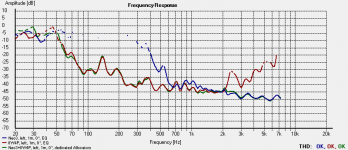 8W4P-Neo3-EQv2-Distortion.png23.9 KB · Views: 90
8W4P-Neo3-EQv2-Distortion.png23.9 KB · Views: 90 -
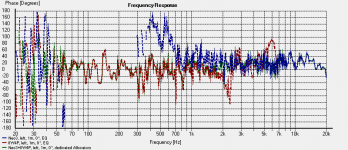 8W4P-Neo3-EQv2-Phase.png37.1 KB · Views: 534
8W4P-Neo3-EQv2-Phase.png37.1 KB · Views: 534 -
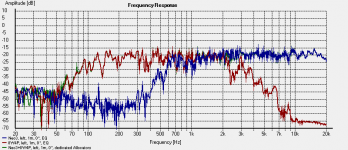 8W4P-Neo3-EQv2-Amplitude.png32 KB · Views: 545
8W4P-Neo3-EQv2-Amplitude.png32 KB · Views: 545 -
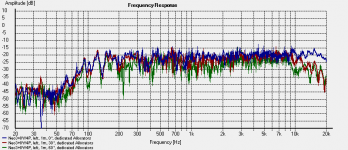 8W4P-Neo3-EQv2-FrontPolar.png33.2 KB · Views: 95
8W4P-Neo3-EQv2-FrontPolar.png33.2 KB · Views: 95 -
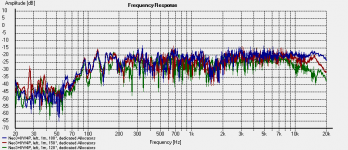 8W4P-Neo3-EQv2-RearPolar.png33.9 KB · Views: 83
8W4P-Neo3-EQv2-RearPolar.png33.9 KB · Views: 83 -
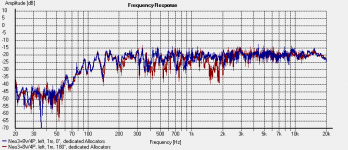 8W4P-Neo3-EQv2-FrontVersusRear.png28.7 KB · Views: 83
8W4P-Neo3-EQv2-FrontVersusRear.png28.7 KB · Views: 83 -
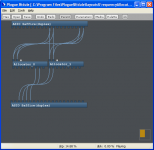 8W4P-Neo3-EQv2-Bidule.png30.4 KB · Views: 113
8W4P-Neo3-EQv2-Bidule.png30.4 KB · Views: 113 -
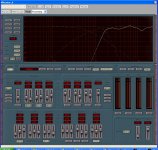 8W4P-Neo3-EQv2-Allocator-Tweeter.jpg103 KB · Views: 122
8W4P-Neo3-EQv2-Allocator-Tweeter.jpg103 KB · Views: 122 -
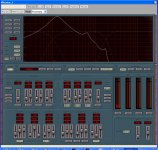 8W4P-Neo3-EQv2-Allocator-Woofer.jpg102.9 KB · Views: 113
8W4P-Neo3-EQv2-Allocator-Woofer.jpg102.9 KB · Views: 113
- Status
- This old topic is closed. If you want to reopen this topic, contact a moderator using the "Report Post" button.
- Home
- Loudspeakers
- Multi-Way
- sanity check on Gainphile S11-StigErik fusion OB
